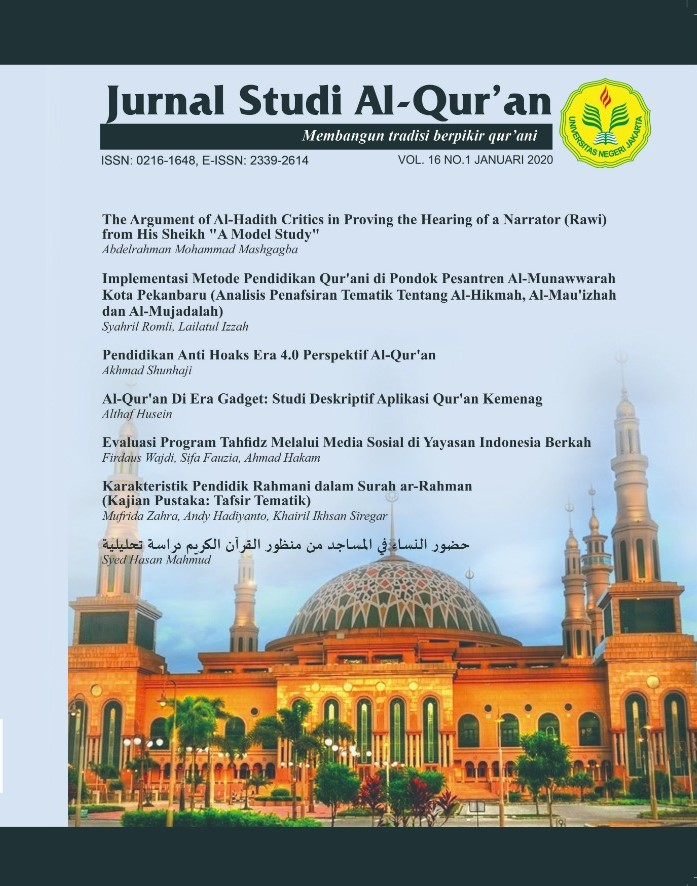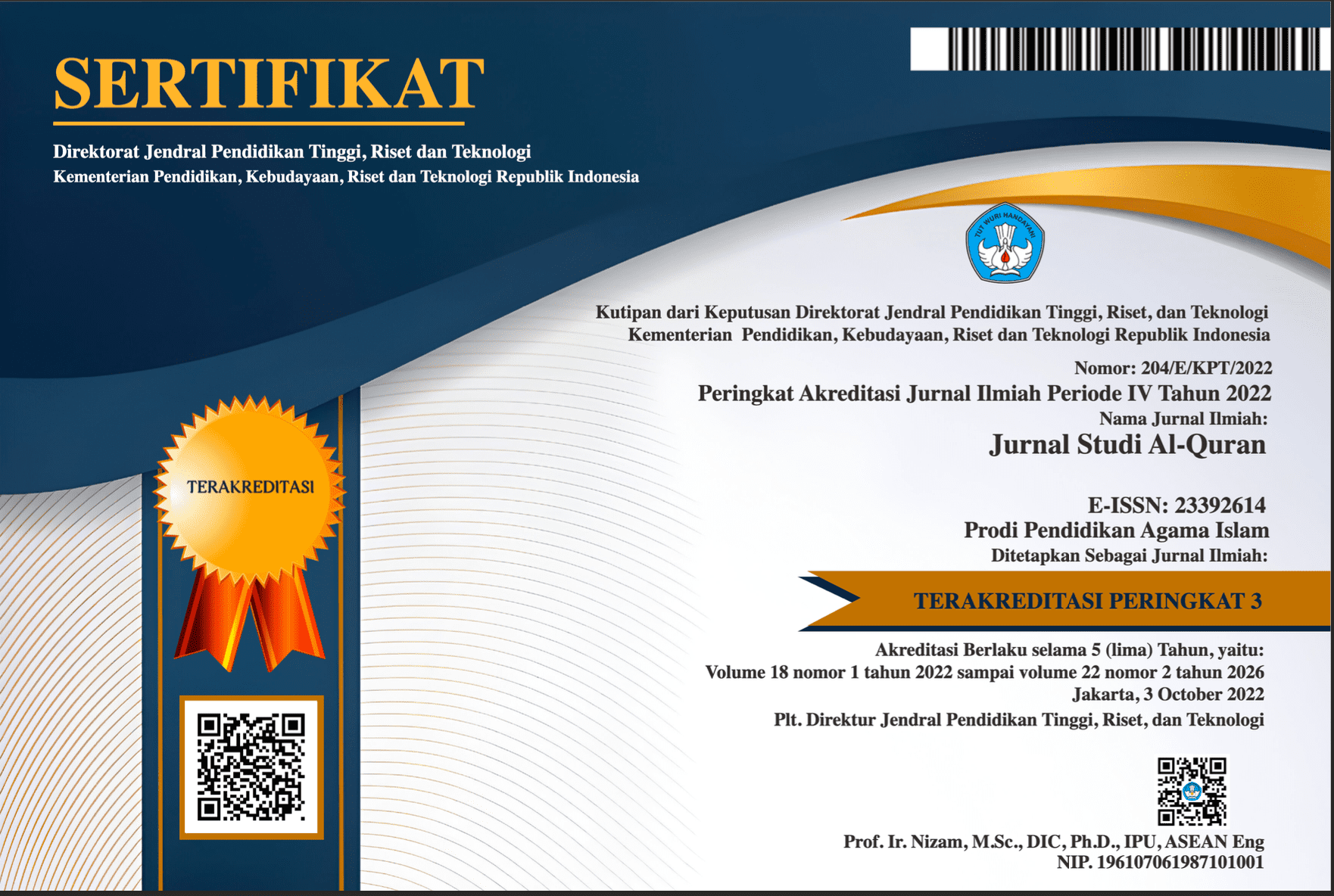Pendidikan Anti Hoaks Era 4.0 Perspektif Al-Qur’an
DOI:
https://doi.org/10.21009/JSQ.016.1.03Keywords:
Education, Hoax, Al-Qur'an perspectiveAbstract
The development of communication technology in the Era of 4.0, gave rise to various kinds of hoax news that could be consumed by various groups of society. The emergence of such massive hoax news, Al-Qur’an has described the impact and the solution. However, most Muslim communities are not aware of it. This paper explores the teachings of the Al-Qur’an about the possibility of hoax through various media developments and solutions. By using a descriptive qualitative approach, the author describes some of the hoax data that developed in Era of 4.0, did the assessment, and found a solutive step to address the hoax according to the Al-Qur’an. Hoax always occurs in the history of human life. The hoax has a negative side that damages many parties. In fact, hoax can interfere with life stability. Therefore, the hoax needs to be addressed wisely. Anti-hoax education from the perspective of the Al-Qur’an is the maximum effort in addressing hoax through the development of teogenetic awareness. In this paper, it was found that teogenetic is the potential of individuals who have an important role in dealing with life problems, including addressing hoax problems wisely.
Keywords: Education, Hoax, Al-Qur'an perspective
References
Daon, Inilah rincian jumlah pelanggan prabayar masing-masing operator, dalam www.kominfo.go.id, diakses pada 5 November 2019.
Diandra, asal-mula situs hoax berkembang di Indonesia, dalam https://www.kominfo.go.id/ content/detail /8629/asal- mula-situs- hoax-berkembang-di-indonesia /0 /sorotan_media diakses pada tanggal6 November 2019
Diandra, Penebar hoax bisa dijerat segudang pasal dalam kominfo. go. id diakses pada tanggal 20 November 2019
Ester Christrine Natalia, Saham Anjlok, Kapitalisasi Pasar Facebook Menguap Rp 1.878 T, dalam https://www.cnbcindonesia.com/tech/20180726110540-37-25453/saham-anjlok-kapitalisasi-pasar- facebook-menguap-rp-1878-t, diakses pada 5 November 2019
Forkomsi FEB UGM, Revolusi Industri 4.0I, Sukbumi, Jawa Barat, CV Jejak, 2019.
Hariyanto, Ibnu, Polri Beberkan Penyebab Hoax Bisa Tersebar Luas di Masyarakat, dalam https://news.detik.com/berita/d-4257442/polri-beberkan-penyebab-hoax-bisa-tersebar-luas-di-masyarakat diakses pada 8 November 2019
https://dictionary.cambridge.org/dictionary/english/hoax diakses pada tanggal 5 November 2019
https://kbbi.kemdikbud.go.id/entri/hoaks diakses tanggal 5 November 2019
https://www.collinsdictionary.com/dictionary/english/hoax diakses pada tanggal 5 November 2019
Idris, Idnan A., Klarifikasi Al-Quran Atas Berita Hoaks, Jakarta: PT Elex Media komputindo, 2018.
Jayani, Dwi Hadya, Jumlah penduduk Indonesia 269 juta jiwa, terbesar keempat di dunia, dalam www.databoks.katadata.co.id, diakses pada 5 November 2019.
Juditha, Christiany, “Interaksi komunikasi hoax di media sosial serta antisipasinya” dalam Jurnal Pekonmas, Vol. 3 No.1, April 2018.
Lies, Ute, dkk, Komunikasi budaya dan dokumentasi kontemporer, Bandung: Unpad Press, 2019.
Maharani, Tsarina, April 2019, 209 terkait politik, dalam https://news.detik.com/berita/d-4532182/kominfo-identifikasi-486-hoax-sepanjang-april-2019-209-terkait-politik diakses pada 11 November 2019
Pertiwi, Wahyunanda Kusuma, Separuh Penduduk Indonesia Sudah "Melek" Media Sosial dalam, https://tekno.kompas.com/read/2019/02/04/19140037/ separuh-penduduk-indonesia-sudah-melek-media-sosial, diakses pada 6 November 2019
Pertiwi, Wahyunanda Kusuma, Separuh Penduduk Indonesia Sudah "Melek" Media Sosial dalam, https://tekno.kompas.com/read/2019/02/04/19140037/ separuh-penduduk-indonesia-sudah-melek-media-sosial, diakses pada 6 November 2019.
Ranang Aji SP, Opini public dan reproduksi hoax, dalam m.detik.com diakses pada 6 November 2019
Rappler.com, Gambaran pemanfaatan teknologi informasi di Indonesia, dalam www.rappler.com, diakses pada 5 November 2019.
Salmah, Af Idah (ed), teologi Islam Terapan, Jakarta: Tiga Serangkat, 2003.
Santhika, Eka, Alasan hoax mudah tersebar di IndonesiaI, dalam https://www.cnnindonesia.com/teknologi/20171019112305-185-249426/alasan-hoax-mudah-tersebar-di-indonesia, diakses pada 12 November 2019.
Sawitri, Angelina Anjar, 4 penyebab hoax mudah viral di media sosial, dalam https://nasional.tempo.co/read/838621/4-penyebab-hoax-mudah-viral-di-media-sosial/full&view=ok, diunduh pada 12 November 2019
Setianto, Eko H. dan Ali Zaki, Tampil beda dengan perangkat digital, Jakarta: PT Elex Media Komputindo, 2008.
Shihab, M. Quraish, Tafsir Al-Misbah Pesan, Kesan dan Keserasian Al-Quran, vol. 9 , Jakarta: Lentera Hati, 2002.
Shunhaji, Akhmad, implementasi pendidikan agama di sekolah Katolik Kota Blitar dan dampaknya terhadap interaksi sosial, Yogyakarta: Aynat Publishing, 2017.
Sudibyo, Agus, Jagat digital, Jakarta: KPG, 2019.
Sugihartati, Rahma, Perkembangan masyarakat informasi & teori sosial kontemporer, Jakarta: Prenadamediagrup, 2014.
Suryadi, Rudi Ahmad dan Aguslani Mushlih, Desain dan perencanaan pembelajaran, Jakarta: Deepublisher, 2019.
Wibowo, Wahyu, Cara cerdas menulis artikel ilmiah, Jakarta: Penerbit Kompas, 2011.
Yunita, Ini Cara Mengatasi Berita “Hoax” di Dunia Maya, dalam kominfo.go.id, diakses pada 6 November 2019.
Zein, Muhammad Fadhilah, Panduan Menggunakan Media Sosial untuk Generasi Emas Milenial, leanpu.com.
Downloads
Published
How to Cite
Issue
Section
License
Authors who publish with this Journal agree to the following terms:
- Author retain copyright and grant the journal right of first publication with the work simultaneously licensed under a creative commons attribution licensethat allow others to share the work within an acknowledgement of the work’s authorship and initial publication of this journal.
- Authors are able to enter into separate, additional contractual arrangementfor the non-exclusive distribution of the journal’s published version of the work (e.g. acknowledgement of its initial publication in this journal).
- Authors are permitted and encouraged to post their work online(e.g. in institutional repositories or on their websites) prior to and during the submission process, as it can lead to productive exchanges, as well as earlier and greater citation of published works.
Users/public use of this website will be licensed to CC BY










